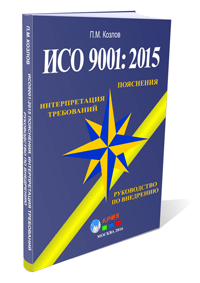BSC is a Balanced Score Card. This is an approach to strategic management of an organization based on setting goals and objectives and measuring their
achievement by a set of indicators representing both financial and non-financial aspects of activity.
CASE - tools Ц (Computer Aided Software Engineering) is computer support tools for software development. CASE tools allow you to design and develop
software and databases business processes model, activities, as well as various structures (organizational, financial, information, etc.) of an
organization.
FMEA analysis (Failure Mode and Effects Analysis) Ц - analysis of the types and consequences of failures. It is used to assess the occurrence and
impact on the consumer of potential defects and inconsistencies in products or processes. As a rule, FMEA analysis is applied at the stage of product
design or process development.
ISO - International Organization for Standardization.
SMART is a way of formulating a goal based on compliance with certain requirements. Each goal should be Specific, Measurable, Attractive, Realistic,
time-limited.
SWOT analysis is a method of analysis used in the strategic management system of an organization. The main factors affecting the state of the
organization are: Strengths, Weaknesses, Opportunities and Threats.
TQM Ц Total Quality Management. It is an approach to organization management based on continuous improvement of the quality of all organizational,
managerial, production and support processes of the organization.
Accreditation is the official recognition by the accreditation body of the individual or legal entity competence to perform work in a certain area of
conformity assessment (Federal Law No. 184 On Technical Regulation).
Audit is a systematic, independent and documented process of obtaining audit evidences and objectively evaluating them in order to determine the
degree of compliance with the agreed audit criteria (ISO 19011:2018).
The Bologna Agreement is an agreement between European countries aimed at the harmonization and mutual recognition of education systems between
European countries. The agreement was signed by the Ministers of Education of 29 European countries in June 1999 in Bologna. The main goal of the Bologna
Agreement is to create a single European higher education area. It was supposed to achieve this goal by 2010.
Process inputs are any objects that are transformed as a result of process operations.
The Ishikawa diagram is a cause-and-effect diagram that allows you to determine the causes of defects in the product. It is one of the quality
management tools. The influence of a certain group of factors is considered in order to determine the causes of defects. The influence of such factors
as "man", "machine", "material", "method", "control" and "environment" is most often considered.
Audit criteria - a set of policies, procedures or requirements (ISO 19011:2002).
IEC Ц International Electrotechnical Commission. Non-profit international organization for standardization in the field of electrical, electronic and
related systems and technologies.
Products are the result of a process (ISO 9000:2015).
A process is a set of interrelated and interacting activities that transform inputs into outputs (ISO 9000:2015).
Quality Function Deployment (QFD) is a technique that allows you to guarantee the quality of a product from the very first stages of the object
creation and development. QFD is a method of converting poorly formalized customer requirements into specific technical requirements of the product and
further into technical characteristics and indicators of the product manufacture processes and its operation processes. Special tables (called "quality
house") are used in order to represent the relationship of the consumer's requirements with the technical requirements for the product, as well as the
relationship of the technical requirements of the product with the parameters of the production and operation processes.
Risk management is a risk management system and financial relations arising in the process of this management.
Certification is a form of confirmation by the certification body of the conformity of objects with the requirements of technical regulations, the provisions
of standards or the terms of contracts (Federal Law No. 184 On Technical Regulation).
QMS - quality management system is an organization management system built on the basis of setting and achieving quality goals.
Activity Based Costing (ABC) is one of the quality management methods used for the systematic study of the object functions (product, service or
process) in order to reduce costs during the design, production and operation of the object. The method is based on determining the ratio of cost and
utility for the consumer of each object functions performed by its elements. Improvement solutions are being developed for elements with a minimum utility/cost ratio.
Functional-physical analysis (FFA) is an analysis method used to optimize and improve the physical characteristics and properties of objects. FFA is
used for newly designed products and modernization of existing products. The method is based on the definition of the functions performed by the components
of the products, the establishment of the physical principles of the elements of the product based on the identified functions and the identification of
technical contradictions arising from the implementation of the physical principles of action. Optimization of product properties occurs due to the elimination
of technical contradictions.
Six Sigma is a methodology for improving the organization's processes by reducing inconsistencies arising in processes. It was used for production processes,
later this methodology was applied to all processes of the organization. The methodology is based on methods for detecting and eliminating the causes of nonconformance
in processes. This methodology was originally developed and applied by Motorola in relation to the production processes of electronic components of products.
